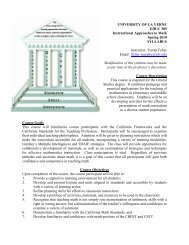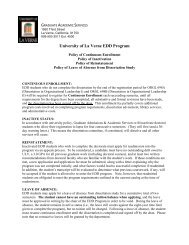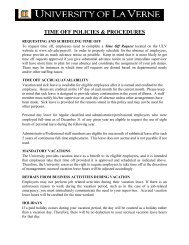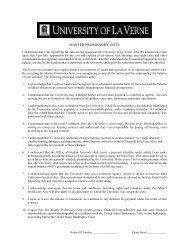College: Making It Happen - CaliforniaColleges.edu
College: Making It Happen - CaliforniaColleges.edu
College: Making It Happen - CaliforniaColleges.edu
Create successful ePaper yourself
Turn your PDF publications into a flip-book with our unique Google optimized e-Paper software.
general entrance requirements: UC is committed to providing a place on one<br />
of its campuses for all eligible applicants who are California residents. Eligible applicants<br />
have grades and test scores that place them in the top 12.5 percent of high<br />
school graduates statewide. Most incoming freshmen have high school grade point<br />
averages of 3.7 or above (a strong “B+” average) in academic courses and combined<br />
SAT verbal, math, and writing scores of 1800 or more, or an ACT score of at least 25.<br />
Students must complete subject, examination, and scholarship requirements and<br />
submit an application during the November filing period.<br />
basic facts and figures: Of the more than 200,000 total students who attend UC,<br />
more than 160,000 are undergraduate students. UC general campuses, where undergraduate<br />
students earn Bachelor’s Degrees, are located in Berkeley, Davis, Irvine,<br />
Los Angeles, Merced, Riverside, San Diego, Santa Barbara, and Santa Cruz. The San<br />
Francisco campus is a graduate campus for health sciences, such as medicine and<br />
dentistry.<br />
For complete information on UC entrance requirements, majors, and campuses,<br />
consult www.universityofcalifornia.<strong>edu</strong>/admissions or “Introducing the University,”<br />
which is available free for high school counselors or on the website.<br />
California’s Non-profit Independent <strong>College</strong>s and Universities<br />
background: California is home to almost 80 private, non-profit independent colleges<br />
and universities. Nine out of ten students receive financial aid; the average financial<br />
aid package is almost $23,000 in order to ensure that college is available to<br />
everyone. The campuses are diverse – 40 percent of the student body are from African-American,<br />
Asian-American, Chicano/Latino, or Native American backgrounds.<br />
Each private non-profit college and university is unique. Students can select the<br />
school and environment that best fits their individual needs. Students enroll directly<br />
out of high school or transfer from community or other colleges. Some schools are<br />
small; others are large. Some are faith-based; a few are for women only. Some focus<br />
on art, or music, or science. Some are in large cities; others are in small towns.<br />
Some have large on-campus communities; others have large commuter student<br />
populations.<br />
general entrance requirements: The admissions requirements are similar to<br />
those at the California State University and University of California systems. Some<br />
“highly selective” and other campuses have very specific requirements related to<br />
their specialties, such as art, music, or technology.<br />
basic facts and figures: Over 280,000 students attend California’s independent<br />
colleges and universities. These schools are not-for-profit institutions that are fully<br />
accredited by the Western Association of Schools and <strong>College</strong>s (WASC). Ninety percent<br />
of students attending independent colleges and universities in California are<br />
satisfied, or very satisfied, with the quality of their <strong>edu</strong>cation.<br />
22<br />
Individualized choices, unique environments, and personal attention allow students<br />
at independent colleges and universities to tailor their college experience to their<br />
own needs while obtaining the skills necessary to succeed in life. For additional information<br />
about the individual schools, go to www.californiacolleges.<strong>edu</strong>.

















